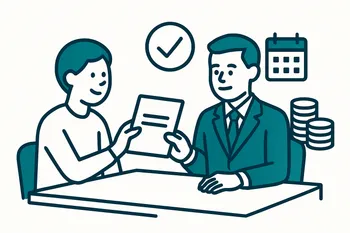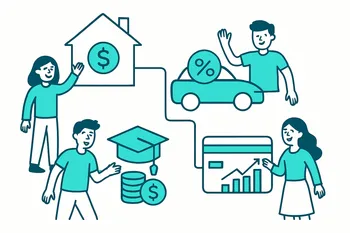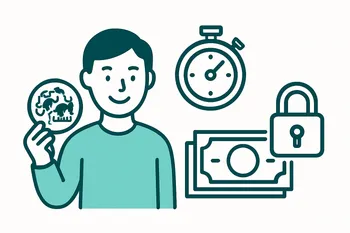How to Apply for a Line of Credit: A Step-by-Step Guide
- Personal Finance
- 04 Mins read

How to Apply for a Line of Credit: A Step-by-Step Guide
Applying for a line of credit can seem daunting, especially if you're new to personal finance. However, with the right information and preparation, you can navigate this process confidently. In this guide, we'll break down everything you need to know to apply successfully.
What is a Line of Credit?
A line of credit is a flexible loan from a financial institution. It allows you to borrow up to a certain limit and pay interest only on the amount you use. Think of it as a safety net for emergencies or funding major purchases, like home renovations or a new car. Unlike a traditional loan, which gives you a lump sum, a line of credit provides ongoing access to funds.
Step 1: Assess Your Financial Situation
Before applying for a line of credit, take a hard look at your finances.
- Check Your Credit Score: Lenders will assess your credit history. A score above 700 is generally seen as good. Free tools like CreditSavvy can help you get this information.
- Review Your Income and Expenses: Make sure you can afford to pay back what you borrow. List your monthly income versus your expenses.
Quote: “Being financially aware is crucial. It empowers you to make informed decisions.”
Keeping your debts in check is essential, as lenders will look at your debt-to-income ratio. This ratio compares how much you owe versus how much you earn. A lower ratio means you're in a healthier financial position.
Step 2: Determine Your Needs
Why do you need a line of credit? Understanding your purpose can help you choose the right type. Some common reasons include:
- Home renovations
- Unexpected medical bills
- Educational expenses
Each reason may affect the type of line of credit you apply for. For example, a home equity line of credit (HELOC) is ideal for renovations, while a personal line of credit may suit other needs.
Step 3: Research Financial Institutions
Not all lines of credit are created equal. Different lenders have varying terms, fees, and interest rates:
- Banks: Usually offer lower interest rates and higher limits but may have stricter application standards.
- Credit Unions: Often more lenient than banks and may offer better rates for members.
- Online Lenders: They provide convenience but watch out for higher fees.
Visit each lender’s website or speak with a loan officer to gather information. Compare the terms to evaluate which option aligns best with your situation.
Step 4: Gather Required Documentation
Before applying, get your documents in order. Here's a checklist:
- Proof of identity: Driver’s license or passport
- Proof of income: Pay stubs, tax returns, or bank statements
- Employment verification: A letter or contact number from your employer
- Financial statements: Any documentation showing your existing debts and spending
Having these ready will speed up the application process and present you as a responsible borrower.
Step 5: Understand the Application Process
Most lenders allow you to apply online, though you can also visit a branch in person.
Here’s a typical process:
- Fill out the application: Provide details about your financial situation and what you intend to use the line of credit for.
- Wait for approval: Some lenders can provide pre-approval in minutes. However, full approval may take a few days.
- Review terms: Once approved, read the terms carefully. Understand the interest rates, fees, and repayment schedule.
Key Takeaways
- Always read the fine print.
- Ask questions if something isn’t clear.
Step 6: Use Your Credit Wisely
Once you have access to your line of credit, use it judiciously. Here are some strategies to consider:
- Don’t max it out: Keeping your usage below 30% of your limit can positively affect your credit score.
- Pay it off regularly: Make minimum monthly payments to avoid interest charges. Pay more if you can, as this reduces your overall debt faster.
Example Scenario
Imagine you have a line of credit of $10,000 and use $3,000 for home repairs. If the interest rate is 10%, the cost of borrowing that $3,000 would be around $300 annually if you paid it off within the year. However, if you constantly max out the line of credit and only make minimum payments, you may end up paying a lot more in interest.
Step 7: Monitor Your Credit and Finances
Keeping an eye on your credit score and overall financial health is essential. Regularly check your credit report and manage your debts wisely.
Tools and Tips
- Use apps like Mint or Pocketbook to track your spending and budget.
- Set up alerts for due payments to ensure you never miss a deadline.
Conclusion
Applying for a line of credit doesn't have to be overwhelming. By understanding your financial situation, researching options, and preparing your documents, you can approach this process with confidence. Whether you're a first-time borrower or someone experienced in managing credit, careful planning is key to successful financial management.
Remember, a line of credit can be a valuable financial tool if used wisely. If you're ever in doubt, don't hesitate to consult with a financial advisor for personalized advice.
By staying informed and proactive, you can make the most of your line of credit, paving the way for brighter financial prospects.



